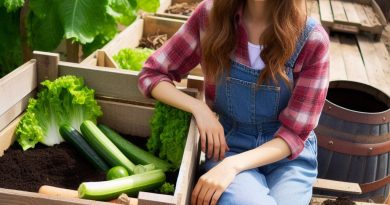Urban Farming: Small Plot, Big Yield
Last Updated on February 1, 2024
Introduction
Growing Food in the City Urban farming refers to the practice of cultivating food crops in small spaces within city environments.
Unlike rural agriculture, urban farms are integrated into built-up areas on vacant lots, backyards, balconies, rooftops, or even indoor spaces.
Urban farming provides fresh produce and greens to city dwellers efficiently and sustainably.
It reduces the distance food travels from farm to fork, cutting carbon emissions.
Urban farms can utilize vertical growing systems and hydroponics to maximize limited space.
Community gardens strengthen social bonds and provide recreation.
Urban agriculture taps unused resources in cities to increase food security.
It helps offset food deserts in low-income neighborhoods lacking access to affordable nutritious options.
Urban farms convert eyesores into green spaces that enhance well-being.
They provide educational opportunities around nutrition and gardening.
Local urban farming creates jobs and keeps money circulating within communities.
With creativity and care, small-scale urban agriculture can yield an abundance of food and wider benefits.
Getting Started with Urban Farming
Urban farming offers numerous benefits, from providing fresh and organic produce to promoting sustainability in densely populated areas.
However, before embarking on this exciting journey, it is essential to start on the right foot.
This section will guide you through three important aspects of getting started with urban farming: choosing the right location, assessing available space, and understanding sunlight requirements.
Choosing the right location
Selecting an appropriate location is crucial to the success of your urban farm.
Look for a spot that receives ample sunlight, preferably facing south.
This orientation maximizes sun exposure throughout the day, ensuring healthy plant growth.
Additionally, consider the proximity to water sources for convenient irrigation.
An easily accessible water supply will significantly simplify the farming process.
It is also important to assess the level of noise and pollution in the area.
While urban farming can mitigate pollution to some extent, choosing a relatively peaceful location will foster a more enjoyable farming experience.
Lastly, evaluate the soil quality in the area or determine whether raised beds or containers will be needed to grow your crops effectively.
Assessing available space
Before you begin planting, it is essential to assess the available space accurately.
Measure the dimensions of the area to plan efficiently and avoid overcrowding.
This step will help you determine if the available space can accommodate your desired crop yield or if adjustments need to be made.
In cases where the available space is limited, consider employing vertical gardening techniques such as trellises or wall-mounted planters.
These innovative approaches allow you to make the most of your space by utilizing vertical surfaces.
Additionally, it is crucial to evaluate the weight-bearing capacity of the area to prevent any potential structural damage due to heavy planters or equipment.
Understanding sunlight requirements
Sunlight is one of the most vital components for successful urban farming.
Different plants have varying sunlight requirements, and understanding these needs is essential.
Research and identify the ideal amount of sunlight your chosen crops need for optimal growth.
Observe the patterns of sunlight in your selected location throughout the day to determine the best placement for your plants.
This analysis will help you ensure that surrounding structures or trees do not block sunlight during the crucial hours.
Moreover, consider using shading techniques when necessary to protect delicate or light-sensitive plants from excessive sun exposure.
Essentially, when starting your urban farming endeavor, choosing the right location, assessing available space, and understanding sunlight requirements are fundamental steps.
Proper planning and preparation in these areas will set the foundation for a successful urban farm, with high-yielding crops and a sustainable approach to food production.
By following these guidelines, you will be well on your way to reaping the benefits of urban farming while making a positive impact on your community and the environment.
Read: City Herbs: Growing Flavor in Tiny Spaces
Maximizing Yield in a Small Plot
Vertical gardening techniques
- Growing vines vertically saves space while producing an abundance of crops.
- Trellises, fences, and vertical structures can be used to support climbing plants.
- Cucumbers, beans, peas, and tomatoes are ideal for vertical gardening.
- Training plants to grow vertically allows for better airflow and sunlight penetration.
- Vertical gardening reduces the risk of plant diseases and improves overall plant health.
Companion planting for efficient space utilization
- Companion planting is a technique where different plants are grown together for mutual benefits.
- Some plants repel pests from others, reducing the need for pesticides.
- Interplanting crops with flowers attracts beneficial insects for natural pest control.
- Planting taller crops next to shorter ones maximizes space utilization and provides shade.
- Beans planted near corn stalks fix nitrogen in the soil, benefitting both plants.
Utilizing raised beds and containers
- Raised beds provide better soil drainage and prevent soil compaction.
- They allow for more control over soil quality and nutrient levels.
- Dividing a small plot into raised beds provides more surface area for planting.
- Containers are suitable for growing herbs, lettuce, and other small crops.
- Containers can be placed on patios, balconies, or in small backyard spaces.
In general, maximizing yield in a small plot can be achieved through various techniques.
Vertical gardening techniques, such as growing vines vertically and using trellises, make efficient use of space while promoting better plant health.
Companion planting allows for pest control without the need for harmful pesticides and maximizes space utilization.
Utilizing raised beds and containers provides better soil drainage, nutrient control, and more surface area for planting.
By implementing these methods, urban farmers can produce a bountiful harvest in even the smallest of spaces.
Read: Watering Tips for Small Gardens & Farms
Selecting Suitable Crops for Urban Farming
When it comes to urban farming, selecting the right crops is crucial for a successful and productive harvest.
Here are some factors to consider when choosing what to grow:
Fast-growing vegetables and herbs
- Opt for crops that have a quick turnaround time, allowing you to enjoy fresh produce sooner.
- Examples of fast-growing vegetables include lettuce, radishes, spinach, and arugula.
- Herbs such as basil, cilantro, and dill also grow quickly and can be harvested in a matter of weeks.
- These crops are perfect for small plots as they don’t require extensive space or a lengthy growing season.
High-yield and compact varieties
- Choose crops that offer high yields, maximizing the amount of food you can produce in a limited space.
- Look for compact varieties that are specifically bred to thrive in small gardens or containers.
- For example, bush beans, cherry tomatoes, and compact zucchini varieties are known for their abundant harvests.
- High-yield and compact plants allow you to make the most of your available land and resources.
Choosing crops based on local climate and conditions
An important aspect of urban farming is adapting to the local climate and conditions.
Consider the following:
- Temperature: Select crops that are well-suited to the temperature range of your area.
- Sunlight: Determine the amount of sunlight your plot receives and choose crops accordingly.
- Water availability: Some crops require more water than others, so consider water availability in your area.
- Soil type: Take into account the type of soil you have and choose crops that thrive in it.
- Disease resistance: Look for varieties that are resistant to common diseases in your region.
By choosing crops that are adapted to your specific climate and conditions, you increase the chances of a successful harvest.
In essence, selecting suitable crops for urban farming is a vital step towards achieving a productive and thriving garden.
By choosing fast-growing vegetables and herbs, high-yield and compact varieties, and crops suitable for your local climate and conditions, you’ll ensure a bountiful harvest from your small plot. Happy farming!
Read: Seasonal Planting Strategies for Hobbyists
Maintaining an Urban Garden
Having an urban garden is not just about planting and harvesting.
It requires proper maintenance to ensure a successful yield.
Here are the key aspects to focus on:
Proper watering techniques
- Water your plants at the base to avoid wetting the leaves excessively.
- Use a watering can or a hose with a nozzle to control water flow.
- Water your plants in the morning to allow them to soak up the moisture throughout the day.
- Monitor the soil’s moisture level regularly and adjust your watering schedule accordingly.
Soil and fertilizer management
- Ensure your soil is rich in organic matter and well-draining for optimal plant growth.
- Test your soil’s pH level to determine if any amendments are needed.
- Add compost regularly to improve soil fertility and structure.
- Choose fertilizers that are suitable for your specific plants and apply them according to the instructions.
Pest control strategies for small spaces
- Inspect your plants regularly for signs of pest infestation, such as holes in leaves or wilting.
- Introduce companion plants that repel pests, such as marigolds to deter aphids.
- Use natural pest control methods like neem oil sprays or insecticidal soaps.
- Regularly remove weeds and fallen leaves, as they can harbor pests.
Maintaining an urban garden requires commitment and consistency.
By implementing these strategies, you can ensure the health and productivity of your plants throughout the growing season.
Read: Composting: A Guide for Urban Farmers

Harvesting and Preserving Urban Farm Produce
In order to fully enjoy the fruits of your labor in urban farming, it is essential to know when to harvest your produce.
Here are some tips to help you determine the perfect time:
Knowing when to harvest
- Observe the appearance and color of the crops to identify maturity.
- Check for ripeness by gently squeezing fruits and vegetables.
- Use the days to maturity information provided on seed packets as a guideline.
Efficient harvesting methods
- Harvest leafy greens, such as lettuce and kale, by simply cutting off outer leaves.
- For root crops like carrots and radishes, gently pull them out of the soil.
- Use pruning shears or scissors to harvest herbs without damaging the entire plant.
- Pick fruits, such as tomatoes and peppers, when they are fully grown and have reached their desired color.
Techniques for preserving and storing produce
Keep produce fresh by following proper storage techniques:
- Remove any damaged or spoiled parts before storing.
- Store fruits and vegetables in separate containers to prevent ethylene gas from affecting them.
- Some produce, like potatoes and onions, can be stored in a cool, dark place with good ventilation.
- Leafy greens should be washed, dried, and stored in airtight bags or containers in the refrigerator.
Consider different preservation methods to extend the shelf life of your harvest:
- Canning: Boil fruits or vegetables in jars with preservatives like salt, sugar, or vinegar.
- Freezing: Blanch vegetables before freezing them to maintain texture and color.
- Drying: Use a food dehydrator or oven to dry herbs, fruits, and vegetables.
- Fermenting: Transform excess produce into tasty fermented goods like sauerkraut or pickles.
By mastering the art of harvesting and preserving, you can make the most of your urban farm produce throughout the year.
Not only will you have a bountiful supply of fresh and nutritious food, but you will also reduce waste and save money.
Community Engagement and Support
Sharing excess produce with neighbors or local food banks
Urban farming not only enables individuals to grow their own fresh produce, but it also presents an opportunity to engage with the community.
One way to do this is by sharing excess crops with neighbors or local food banks.
By donating these surplus fruits and vegetables, urban farmers not only reduce waste but also help provide nutritious food to those in need.
This act of generosity can foster stronger bonds within the community and promote a sense of collective responsibility towards food security.
Participating in community gardens or urban farming initiatives
Another way to engage with the community is by actively participating in community gardens or urban farming initiatives.
These projects bring together like-minded individuals who are passionate about sustainable agriculture and food sovereignty.
Shared plots or common spaces allow urban farmers to learn from one another, exchange ideas, and collectively work towards a greener, more sustainable neighborhood.
By joining forces, urban farmers can advocate for supportive policies and create a stronger voice for urban agriculture in their community.
Connecting with urban farming organizations and resources
To further strengthen community engagement and support, it is essential to connect with urban farming organizations and resources.
These organizations often provide valuable guidance, workshops, and networking opportunities.
They can offer expert advice on various aspects of urban farming, such as soil management, pest control, and maximizing yield in small spaces.
By tapping into these resources, urban farmers can enhance their skills, stay informed about the latest trends, and collaborate with other enthusiasts in their community.
Local food banks
Local food banks play a critical role in ensuring food security for vulnerable populations.
By partnering with these organizations, urban farmers can provide fresh, nutritious produce directly to those who need it most.
Donating surplus crops to food banks not only helps alleviate hunger but also promotes healthier eating habits within the community.
Community gardens
Participating in community gardens is an excellent way to build connections and learn from experienced urban farmers.
These shared spaces allow individuals with limited land or resources to grow their own food and contribute to a collective effort.
Community gardens often organize events, workshops, and social activities, fostering a sense of belonging and empowerment among participants.
Urban farming organizations
Urban farming organizations, both local and national, are invaluable resources for urban farmers.
They often offer training programs, mentorship opportunities, and access to funding or grants.
By connecting with these organizations, urban farmers can tap into a wealth of knowledge and support, ultimately contributing to the growth and success of urban agriculture in their community.
In a nutshell, community engagement and support are vital aspects of urban farming.
By sharing excess produce, participating in community gardens, and connecting with relevant organizations, urban farmers can foster a sense of camaraderie, strengthen their skills, and work towards a more sustainable and resilient community.
Together, individuals can create a thriving urban farming movement that not only yields bountiful harvests but also enriches the lives of those involved.
Conclusion
Urban farming offers numerous benefits that make it a worthwhile endeavor.
By utilizing small plots of land creatively, individuals can yield significant harvests and contribute to their own food security.
Urban farming promotes sustainability by reducing the carbon footprint associated with traditional agriculture.
The proximity of these farms to urban centers also reduces transportation costs and emissions.
Additionally, it provides access to fresh and healthy produce in areas where food deserts are prevalent, improving overall community health.
If you’re considering starting an urban farm, now is the perfect time to dive in.
The demand for locally grown produce is on the rise, and urban farming presents an opportunity to meet that demand while also fostering a sense of community and connection with nature.
Don’t be discouraged by limited space or lack of experience.
Start small and experiment with different crops and techniques.
There are numerous resources available, from online tutorials to local gardening groups, that can provide guidance and support.
The future of urban agriculture looks promising.
As the world’s population continues to grow, cities need sustainable solutions to feed their residents.
Urban farming offers a viable option that can help mitigate food insecurity, reduce environmental impact, and create resilient communities.
So, whether you have a small plot of land or just a few containers on a balcony, consider taking up urban farming.
Your efforts will not only yield a bountiful harvest but also contribute to a greener, healthier, and more sustainable future for all.


